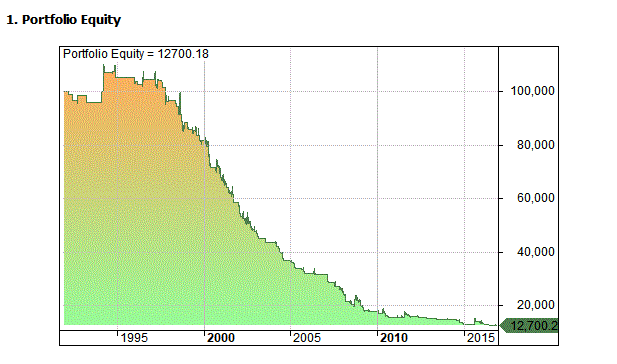I’ve been doing some work on volatility products and I’m particularly interested in finding long volatility strategies.
Unfortunately, there are several reasons why betting on volatility going up is difficult:
- Stock markets tend to go up and volatility tends to drop.
- Volatility products that track the VIX suffer from time decay.
- Macroeconomic factors and central banks work to reduce volatility.
Despite these issues, I think there are several good reasons why betting on volatility can make sense:
- Volatility is mean reverting and is bound to return at some point.
- Short volatility is a crowded trade and could blow up dramatically.
- Long volatility is a good hedge for other markets.
- Long volatility is a good hedge for our short volatility trade.
Because of this, I have been looking at some ideas for going long volatility.
Idea One – Buy VIX After Strong S&P 500 Performance
A recent article on Bloomberg claimed that the more the market moves today, the more volatile it is likely to be tomorrow.
Sounds good in theory but I could not make any sense of the below chart which was provided without any further details:

The chart appears to show that next day volatility increases when the S&P 500 monthly return is roughly over 10% or under -3%.
I therefore tested a strategy of going long on the VIX index for one day whenever the S&P 500 monthly return was over 10% or under -3%.
Unfortunately, the results from testing such a strategy were extremely poor. In fact, the strategy lost 60% of the time and it lost 87% of the starting capital (using 20% position size) over the time period:

I don’t know how the Bloomberg chart above was produced but the findings do not seem to translate into a profitable trading opportunity.
A slightly better strategy is to simply go long VIX for one day whenever the S&P 500 1-day return is over 3%.
The performance is still pretty bad though:

Idea Two – Buy VXX When VIX Is Under 10
Another popular idea is to go long whenever the VIX index hits a significant low (such as under 10) and then close the trade two weeks later.
Such an event has occurred 17 times between 1/1992 – 9/2017 and has been profitable 82% of the time on the VIX index.
These are great numbers but unfortunately we cannot trade the VIX index outright. So here is the equity curve for the strategy applied to VXX back to 2010:

As you can see, even though the strategy is profitable on the VIX index, it has been a loser on the VXX ETF due to the impact of time decay.
Actually, a better solution is to buy VXX when the VIX hits a low under 10 and then sell on the very first up close.
This strategy has worked 71% of the time on VXX (although all trades came in 2017) with an average profit of just over 1.26%:

Idea Three – Volatility Of Volatility
Another possibility is to trade the volatility of volatility. In other words, when the volatility of the VIX is low, investor sentiment is even more complacent so you should get ready to go long.
It may sound crazy but there is even a new index that measures it called VVIX.
In the next test, we go long VXX when the 20-day standard deviation of the VIX crosses from a low level to over 1. We then exit the trade on the first up close.
This solution produced an average profit per trade of 1.77% and a win rate of 53% across 36 trades. Not such a bad result and worth looking into some more:

When To Go Long Volatility
In this article we have shown some simple ideas that might be used to go long volatility. We also said that buying volatility could be a worthwhile strategy for hedging purposes.
The truth is that no trading system can realistically predict volatility accurately. After all, no technical system is able to predict the next time Donald Trump sends an undiplomatic Tweet or Kim Jong-Un fires a nuclear missile.
That is one reason you should combine some element of experience and context in your systematic trading. Using an event based framework could also be an additional next step to developing volatility trading strategies.
For example, a lot of the time volatility will increase as an important event nears on the horizon. Brexit or the US election are prime examples. These events provide excellent opportunities to go long volatility from low levels as they provide low risk entries. The weekend also tends to see increased volatility because markets are closed so some traders will enter VXX positions on Fridays and exit on Mondays.
Overall what we have shown is that it’s better to be long volatility after periods of low volatility. Just like it is better to be short volatility after periods of high volatility. It is also important to keep your volatility trades short and highly targeted to avoid the perils of time decay.
There are surely many opportunities in the volatility space and they could be explosive under the right circumstances.
—
Charts and simulations produced in Amibroker with data from Norgate. Simulations include commissions of $0.01 per share and entries placed on next bar open.
